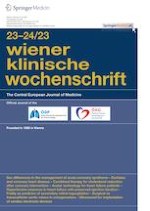Introduction
Patients, material and methods
Results
No frailty (n = 112) | Frailty (n = 127) | p-value | |
|---|---|---|---|
Age—years | 80 (74–85) | 85 (80–89) | < 0.001 |
Male sex | 44% (49) | 42% (53) | 0.75 |
Reason for hospitalization | – | – | 0.912 |
Heart failure | 50% (55) | 50% (64) | – |
Other cardiologic diseases | 14% (15) | 12% (15) | – |
Other causes | 37% (41) | 38% (49) | – |
Echocardiography | |||
Mitral regurgitation | – | – | 0.45 |
Moderate | 71% (80) | 67% (85) | – |
Severe | 29% (32) | 33% (42) | – |
Vena contracta—mm | 6 (5–7) | 6 (5–8) | 0.39 |
LVEDD—mm | 49 (42,5–57) | 50 (44–59) | 0.45 |
Left atrial size—cm2 | 28 (23–35) | 30 (25–35) | 0.61 |
LVEF | – | – | 0.61 |
Preserved (≥ 50%) | 46% (51) | 43% (54) | – |
Mildly reduced (41–49%) | 25% (28) | 22% (28) | – |
Reduced (≤ 40%) | 29% (33) | 35% (45) | – |
Aortic stenosis | – | – | 0.98 |
Absent | 81% (91) | 79% (100) | – |
Mild | 5% (6) | 6% (8) | – |
Moderate | 6% (7) | 6% (8) | – |
Severe | 7% (8) | 8% (10) | – |
Comorbidities | |||
EuroSCORE2 | 5.9% (6.4%) | 6.8% (8.5%) | 0.37 |
Coronary artery disease | 33% (37) | 22% (28) | 0.057 |
Diabetes mellitus | 17% (19) | 24% (30) | 0.20 |
Insulin-dependent | 4% (4) | 6% (8) | 0.34 |
Atrial fibrillation | 71% (79) | 70% (89) | 0.94 |
Extracardiac arteriopathy | 22% (25) | 35% (44) | 0.036 |
Previous cardiac surgery | 5% (6) | 6% (7) | 0.96 |
Chronic lung disease | 16% (18) | 15% (19) | 0.81 |
NYHA classification | – | – | 0.57 |
I | 45% (50) | 43% (55) | – |
II | 14% (16) | 15% (19) | – |
III | 26% (29) | 20% (26) | – |
IV | 15% (17) | 21% (27) | – |
CCS class 4 angina | 5% (6) | 6% (7) | 0.96 |
Recent myocardial infarction—within 90 days | 2% (2) | 0% (0) | 0.13 |
Renal function (GFR) | – | – | 0.37 |
Normal (> 85 ml/min) | 22% (25) | 17% (21) | – |
Moderately impaired (50–85 ml/min) | 54% (60) | 53% (67) | – |
Severely impaired (< 50 ml/min) | 24% (27) | 31% (39) | – |
No frailty (n = 112) | Frailty (n = 127) | p-value | |
|---|---|---|---|
Dementia | 5% (6) | 28% (35) | < 0.001 |
Poor mobility | 21% (23) | 65% (83) | < 0.001 |
Polypharmacy—≥ 5 medications daily | 83% (93) | 93% (118) | 0.018 |
Frailty (CFS) | – | – | < 0.001 |
Non-frail (1–3) | 100% (112) | 0% (0) | – |
Mild to moderate (4–6) | 0% (0) | 70% (89) | – |
Severe (7–9) | 0% (0) | 30% (38) | – |
Living situation at admission | – | – | < 0.001 |
Autonomous | 78% (87) | 37% (47) | – |
Support from relatives | 14% (16) | 27% (34) | – |
Home nursing care | 5% (6) | 19% (24) | – |
Nursing home | 3% (3) | 17% (22) | – |
No frailty (n = 112) | Frailty (n = 127) | p-value | |
|---|---|---|---|
1‑year mortality | 3% (3) | 15% (19) | 0.001 |
Combined endpoint 1‑year | 14% (16) | 43% (55) | < 0.001 |
Univariate model | Multivariable model | |||||
|---|---|---|---|---|---|---|
HR | 95% CI | p-value | aHR | 95% CI | p-value | |
No frailty | Reference | – | – | Reference | – | – |
CFS 4–6 | 3.39 | 1.88–6.11 | < 0.001 | 3.35 | 1.85–6.05 | < 0.001 |
CFS > 6 | 4.49 | 2.31–8.74 | < 0.001 | 4.54 | 2.33–8.86 | < 0.001 |
